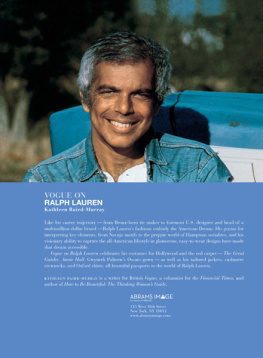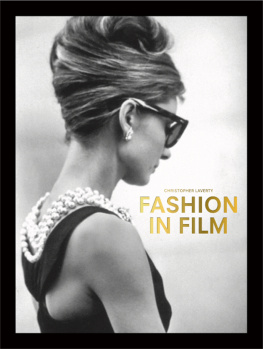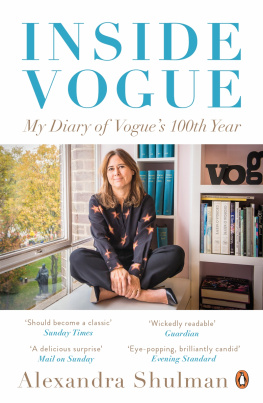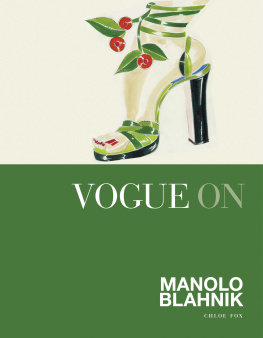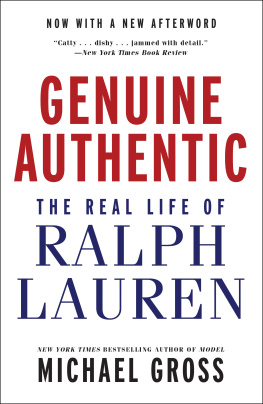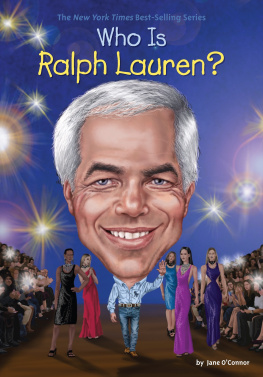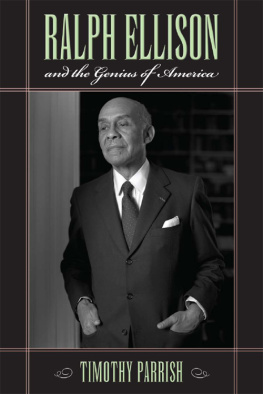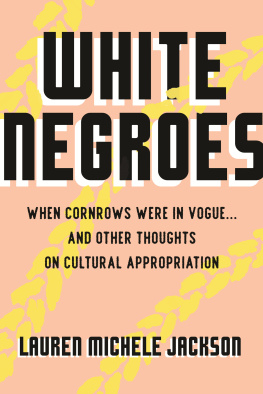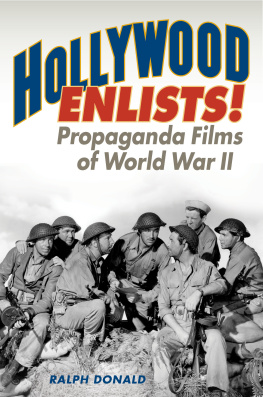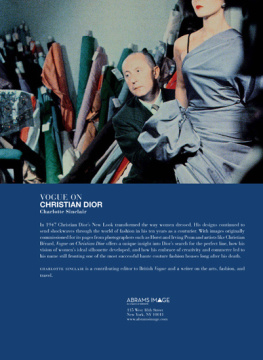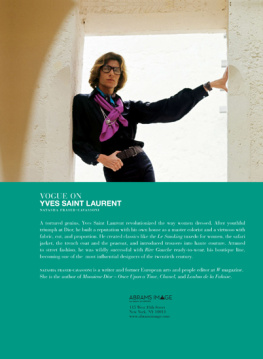
A sketch from Laurens 1978 Western wear collections; relaxed cowboy clothes that feel authentic.


Naomi Campbell and Christy Turlington bring a touch of sequinned glamour to a Ralph Lauren classic: the nautical stripe. Photographed by Arthur Elgort for American Vogue, 1992.

Born in the USA: Ralph Laurens well-worn denims are trademarks of his unmistakable American ease.
CONTENTS
RALPH HAS CREATED A WORLD THAT YOU FEEL YOU CAN ENTER WHEN YOU BUY SOMETHING BEARING HIS NAME, WHETHER THAT BE A PAIR OF JEANS, BLANKET, A COAT OR A PAIR OF SOCKS.
ALEXANDRA SHULMAN
EVERYBODYS ALL AMERICAN
A
T he year was 2007, the city, Moscow, and a pair of gold scissors sat on a small white box, waiting to cut the blue satin ribbon that stretched across the front of the three-story, 1870s mansion. Television crews, paparazzi, reporters, and guests waited excitedly in Tretyakovsky Passage, trying to steal a peek inside the new 8,000-square-foot (740-square-meter) Ralph Lauren store replete with glittering chandeliers, their largest accessories department, and enough Ralph Lauren memorabilia to satisfy the most zealous of fans. Having flown in with an entourage from New York, the eponymous owner, tanned and silver haired, stood at the entrance with Ricky his wife of (then) 42 years who looked enviably svelte in a gold-embroidered tuxedo. Two of their three children, David and Dylan, accompanied them on either side. The cameras flashed. The gold scissors cut the ribbon, the crowd cheered, and Ralph Lauren Moscow was officially open.
For anyone wondering how this all began, how a tie salesman from the Bronx could end up heading a global corporation netting $7 billion in 2012 alone, the answer was inside the store. Beyond the Ricky handbags, the paint, the perfume, the pillowcases, and the covetable Collection evening gowns, lay a pile of neatly folded soft cotton polo shirts in an array of rainbow colors. On the left breast of each shirt sat an emblem of a man on a horse with a polo mallet raised high in the air. Both endearing and enigmatic, Ralph Laurens inimitable polo-player logo was internationally almost as well-known as that other symbol of all-America: Coca-Cola. As British Vogue wrote in 1999, the logo and the brand it stood for had become a blueprint for the label-as-global-presence. The opening in Moscow was the sixth flagship store and came 40 years after the inception of the house.
Renowned for its classic aesthetic yet with an unnerving ability to capture the essence of what people want before they even know it, a Ralph Lauren collection has always had a basic premise: to offer something to wear when life demands clothes that feel good but dont make you look like youre trying too hard, (Joan Juliet Buck, American Vogue, 1992). Credited with creating the lifestyle concept, Lauren has never been about fashion for fashions sake; his are clothes for the lives people would like to be living as well as the lives people are living. Whether preppy or redolent of the prairie; rugged and outdoorsy or red-carpet fantasy; encompassing the soft pink taffeta gown worn by Gwyneth Paltrow to the Oscars or the mannish garb of Diane Keaton in Woody Allens classic New York love story, Annie Hall, Laurens clothes smack of authenticity. As Buck put it: The clothes of Ralph Lauren are a form of cinema, they fulfill the private function known in movies as the back story telling you who you are and who you were and where you come from and the public function of demonstrating these things to other people.
A
THE CLOTHES OF RALPH LAUREN ARE A FORM OF CINEMA, THEY FULFILL THE PRIVATE FUNCTION KNOWN IN MOVIES AS THE BACK STORY.
JOAN JULIET BUCK

The dream Lauren lifestyle at the beach: Ralph and Ricky with their sons in 1978, photographed by Les Goldberg.

Tailored suiting with feminine appeal. Lauren introduced the concept of sportswear with a small s, as seen in this photograph by Mike Reinhardt for American Vogue, 1974.
With the Moscow store opening, there was a temptation for the press to re-create Laurens own back story. Here, wrote some, drawing on Laurens much-publicized Russian origins, was everyones all-American boy returning to his roots, a quiet homecoming amidst all the gloss and the glamour. After all, the designer who had put the American flag so firmly on the world map of fashion was known to be fascinated by Russia; you could see it in some of his collections over the years. But while the young Lauren had indeed grown up hearing about Belarus from his father and mother, who were born in Pinsk (a part of the Soviet Union until 1991 but now in Belarus), the reality to any back story, wasas it invariably isdistinct from the romance. It was very exciting to come to Russia, said Lauren in an interview with the New York Times, There is a connection to my heritage but where I grew from is foreign to me.
R alph Lauren was born in New York on October 14, 1939, the youngest son of Frank and Frieda Lifshitz, who had emigrated to the city in the early twentieth century. They had met in their teens at a Russian social club, married, had three children, Thelma, Leonard, and Jerome, before Ralph came along, and they lived in Mosholu Parkway, the Bronx. Laurens father was an accomplished artist, painting intricate murals and creating wood-effect paintwork. Surrounded by artefacts from Europe and sepia photographs of his parents wedding, Ralph listened to a mix of Russian, Polish, and Yiddish (spoken by his parents when they didnt want their children to understand them). Lauren would later draw upon a Persian lamb hat that belonged to his mother as inspiration for a Russian-themed show with Cossack tunics, greatcoats, and Bolshevik tweeds; a theme he would return to on several occasions.

Hurrah for the Hussar! A velvet jacket and velvet stretch leggings reference Laurens admiration for military style, captured by Arthur Elgort in American Vogue, 1991.
A
A GRACEFUL LEAP OF IMAGINATION INTO THE REVIVAL OF GLAMOUR.
VOGUE
Of his unremarkable upbringing, Lauren has said: I didnt dream of a certain life, I wasnt obsessed. I was a happy middle-class Jewish kid in the Bronx. Despite growing up in the same area and at the same time as Calvin Klein (they wouldnt meet until much later in life), there was nothing about Mosholu Parkway that pointed to a career in fashion. There was, however, one small, important difference setting the young Lauren apart from his friends, which would later turn out to be the key to his future. Unusually, he had a strong sense of style, and was very much aware of what was tasteful sartorially and what wasnt. Lauren was known for his sense of dress, even designing warm-up jackets for his baseball team when he was fifteen. He would root out army surplus stock and wear safari jackets and military clothes, and loved them because: They werent rugged. They werent designed. They were worn by soldiers, for real things, and thats what I loved. With his brothers hed source tartan plaid shirts or duck-hunting jackets from gun stores. His style heroes were Cary Grant, the Duke of Windsor, and Fred Astaire; as a result he devoured movies and biographies, anything that told him more about their worlds.
Next page
